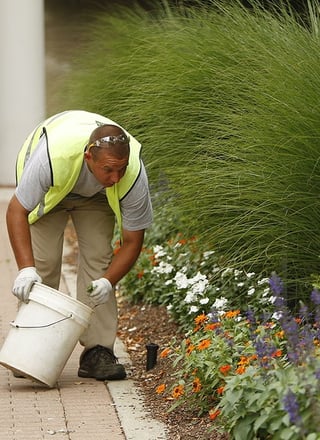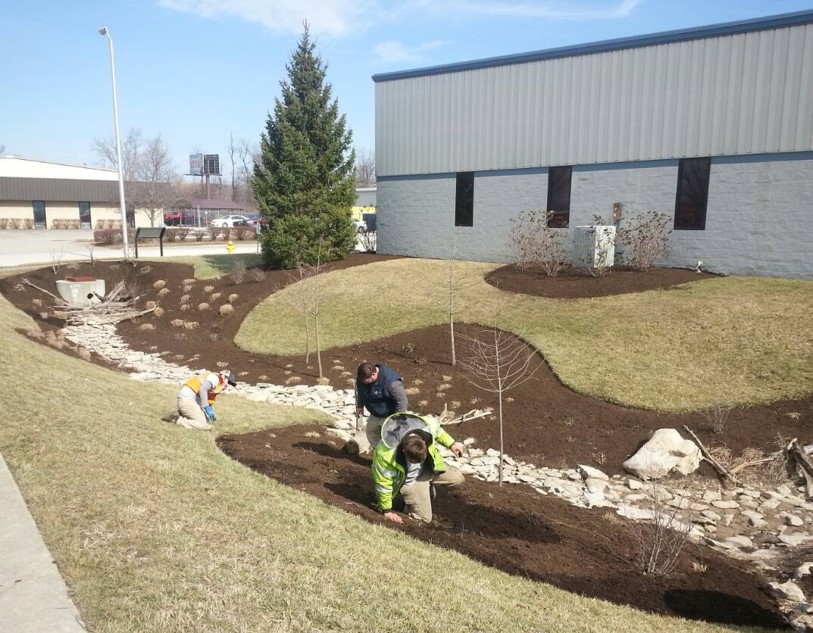Spring is here. That’s why we’re talking to property managers now about important tasks to prepare their landscapes for summer. Landscape spring cleanup sets the stage for success the rest of the growing season, and it’s critical before you can truly “move on” to other landscape maintenance activities.
The level of spring cleanup your property requires depends on whether it was cared for during winter. Properties that receive winter services including debris cleanup and weed removal will have less of a job come spring. That’s one reason why we recommend winter cleanup services as part of a year-round commercial grounds maintenance program. Continuity of service ensures the best results.
Whether or not you elected winter services, it’s time to spring into the warm-season and plan for cleanup. Here is a landscape spring cleanup checklist so you know what to expect.
#1 Remove Debris and Trash
 Think of debris and trash removal as “cleaning the slate” of your landscape so you can begin other spring cleanup activities to prepare your grounds for the growing season. During the winter, debris and trash build up on your property from nature and the modern environment. For example, some trees hang on to their leaves during fall and will drop foliage throughout the winter months. Also, wind kicks up green debris from the landscape—brush, mulch, sticks, etc. Meanwhile, trash from pedestrians and vehicles blows on to properties and should be removed.
Think of debris and trash removal as “cleaning the slate” of your landscape so you can begin other spring cleanup activities to prepare your grounds for the growing season. During the winter, debris and trash build up on your property from nature and the modern environment. For example, some trees hang on to their leaves during fall and will drop foliage throughout the winter months. Also, wind kicks up green debris from the landscape—brush, mulch, sticks, etc. Meanwhile, trash from pedestrians and vehicles blows on to properties and should be removed.
#2 Weed Landscape Beds
After cleaning up debris, we address cool-season weeds that can grow all winter. Property managers that elect winter services will require less weeding because we take care of this task as we see weeds crop up in beds. (It’s valuable to do winter weeding to maintain a neat appearance year-round.) Weeding is essential before edging landscape beds and applying mulch. Basically, this step is phase two of achieving a clean slate.
#3 Cut Back Perennials
We always recommend leaving perennials until spring because the dormant plants and grasses act as homes for beneficial insects and butterflies. If you cut back perennial plants and grasses in fall, which many property owners are apt to do, then you essentially remove those hibernating spots for important creatures. Ideally, we try to leave perennial plants and grasses standing as long as possible into Spring to ensure the survival of the greatest number of beneficial insects and butterflies. (Rather than thinking of the perenials as messy—think of them as homes!) Cutting back perennials sets the stage for new growth.
#4 Edge Landscape Beds
Nice, clean landscape bed lines that are properly edged improve the appearance of your property. But bed edging does far more than improve appearance. Bed edging can: 1) prevents material loss; 2) maintains bed shape and form; and 3) creates edged tree rings that protect plants’ trunks.

#5 Lay Down Mulch
After removing debris and weeding, and then edging beds, mulch is applied to landscape beds. Mulch is beneficial because it reduces erosion, helps control weeds, limits soil evaporation and moderates soil temperature. Of course, mulch makes beds look good. But beyond curb appeal, it does so much more to enhance the health of plants and soil.
#6 Apply Pre-Emergent Weed Preventive
Now that you’ve created a nice, clean appearance and set up your landscape for a healthy growing season, prevent weeds from cropping up by using a pre-emergent herbicide product. While mulch suppresses weed growth, an application of pre-emergent will double up the effort. At Klausing Group, we consider pre-emergent an essential aspect of mulching and preparing beds for planting. Always remember to read you labels, though, as pre-emergent cannot be used under all types of plants.
Get Set for Spring Now
Beyond these six steps, there are additional spring services that provide that continuity of care to carry your landscape into the summer season. Those activities include plant fertilization, insect and disease control, and turf preparation, and an experienced landscape professional can talk to you about the services your property will require.
Remember, landscape spring cleanup sets a solid foundation for plant health and vitality. These basic steps are essential before other spring services and planting can begin. Let’s talk more. Call us any time in Lexington at 859-254-0762, or in Louisville at 502-264-0127. Or, fill out this simple contact form and we’ll get in touch with you.


